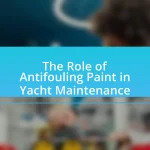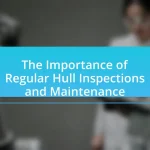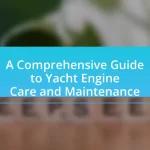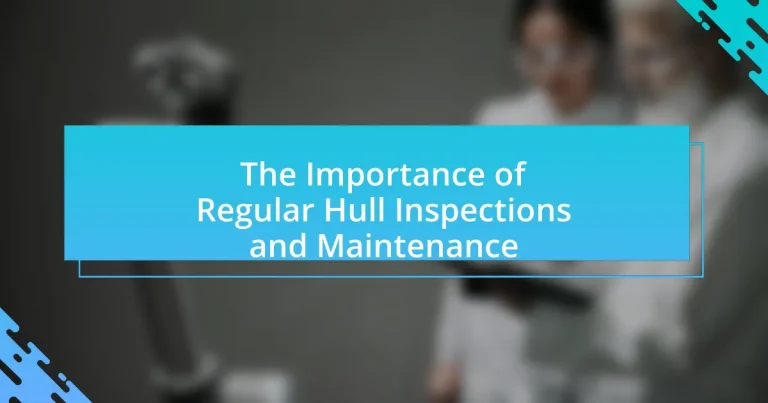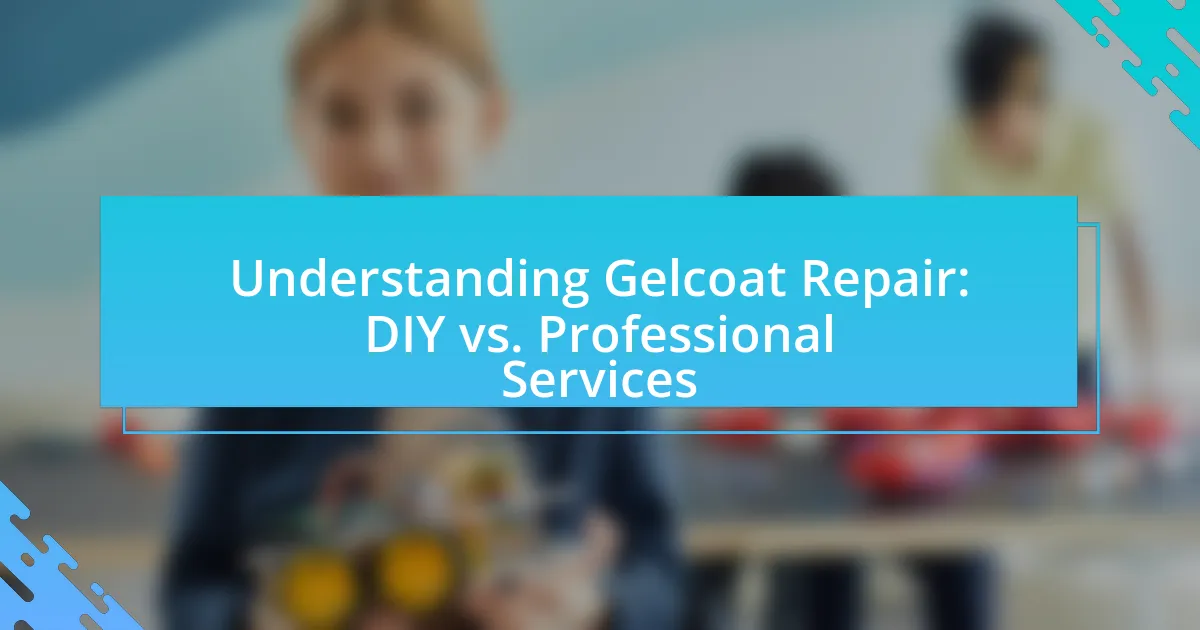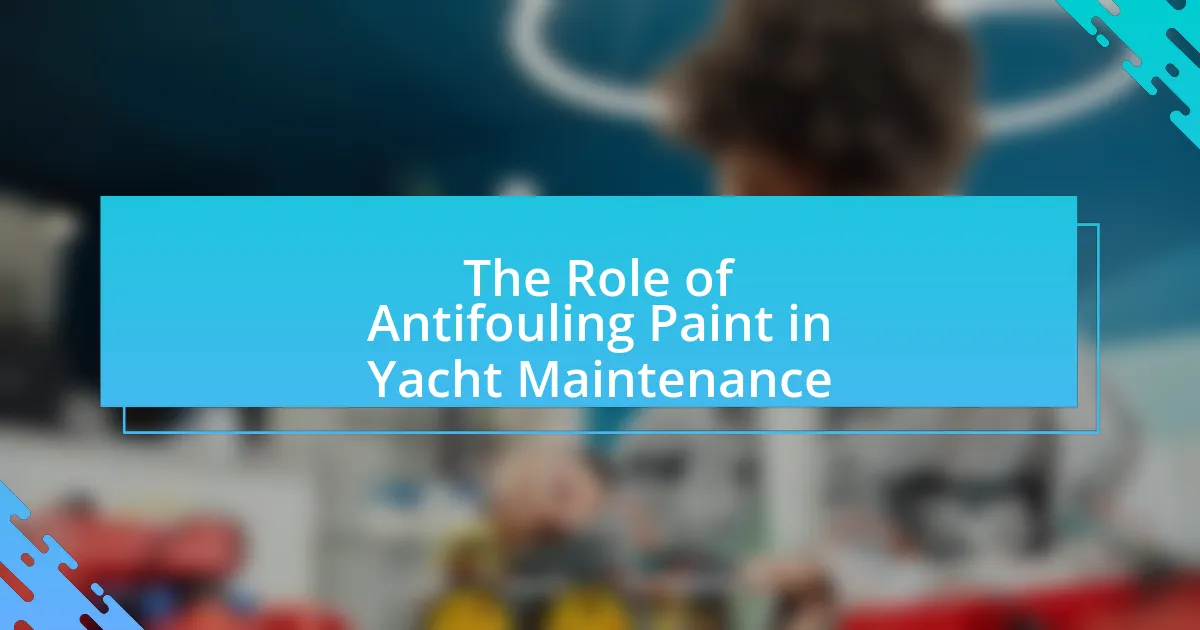Regular hull inspections and maintenance are essential for ensuring the safety, performance, and longevity of vessels. These practices help identify structural issues such as cracks and corrosion, which can compromise hull integrity and lead to accidents. The article highlights the critical role of inspections in enhancing vessel safety, reducing maintenance costs, and preventing environmental hazards. It also outlines key components of hull maintenance, the frequency of inspections, and the financial implications of neglecting hull care. Additionally, it discusses best practices and technologies that aid in effective hull maintenance, emphasizing the importance of proactive measures to extend the operational life of vessels.

What is the Importance of Regular Hull Inspections and Maintenance?
Regular hull inspections and maintenance are crucial for ensuring the safety, performance, and longevity of a vessel. These inspections help identify structural issues, such as cracks or corrosion, that could compromise the integrity of the hull. According to the American Bureau of Shipping, regular maintenance can prevent costly repairs and enhance the vessel’s operational efficiency by up to 20%. Additionally, maintaining the hull reduces the risk of accidents and environmental hazards, as a well-maintained hull minimizes the likelihood of leaks and spills.
Why are hull inspections critical for vessel safety?
Hull inspections are critical for vessel safety because they identify structural weaknesses and potential failures that could lead to catastrophic incidents. Regular inspections help detect corrosion, cracks, and other damage that may compromise the integrity of the hull, ensuring that vessels remain seaworthy. According to the International Maritime Organization, approximately 80% of marine accidents are attributed to human error, with many of these incidents preventable through proper maintenance and inspections. By adhering to inspection protocols, vessel operators can mitigate risks, enhance safety, and comply with regulatory standards, ultimately protecting lives and the marine environment.
What risks are associated with neglecting hull inspections?
Neglecting hull inspections poses significant risks, including structural damage, increased maintenance costs, and safety hazards. Structural damage can lead to leaks or breaches, compromising the vessel’s integrity and potentially resulting in sinking. Increased maintenance costs arise from undetected issues that worsen over time, leading to more extensive repairs. Safety hazards include the risk of accidents due to equipment failure or loss of stability, which can endanger crew and passengers. According to the American Bureau of Shipping, regular inspections can prevent up to 70% of marine accidents related to hull integrity, underscoring the critical need for consistent maintenance.
How do hull inspections contribute to overall maritime safety?
Hull inspections significantly enhance overall maritime safety by identifying structural weaknesses and potential failures before they lead to catastrophic incidents. Regular inspections allow for the early detection of corrosion, cracks, and other forms of damage that could compromise the vessel’s integrity. According to the International Maritime Organization, approximately 80% of marine accidents are attributed to human error, often exacerbated by equipment failure; thus, ensuring the hull is in optimal condition directly mitigates risks associated with such failures. By maintaining the hull’s structural soundness, inspections contribute to preventing leaks, ensuring buoyancy, and enhancing the vessel’s stability, all of which are critical for safe navigation and operation at sea.
What are the key components of hull maintenance?
The key components of hull maintenance include regular inspections, cleaning, painting, and repairs. Regular inspections help identify issues such as cracks, corrosion, or marine growth, which can compromise the hull’s integrity. Cleaning the hull removes algae, barnacles, and other debris that can affect performance and fuel efficiency. Painting, particularly with anti-fouling coatings, protects the hull from corrosion and marine growth, extending its lifespan. Repairs address any damage found during inspections, ensuring the hull remains seaworthy. These components are essential for maintaining the vessel’s safety and performance in marine environments.
What types of inspections should be conducted regularly?
Regular inspections that should be conducted include visual inspections, structural integrity assessments, and safety equipment checks. Visual inspections focus on identifying visible signs of wear, corrosion, or damage on the hull, while structural integrity assessments evaluate the overall strength and stability of the vessel’s structure. Safety equipment checks ensure that all safety gear, such as life jackets and fire extinguishers, are in proper working condition. These inspections are crucial for maintaining the vessel’s performance and safety, as they help prevent accidents and extend the lifespan of the hull. Regular adherence to these inspection types is supported by maritime safety regulations, which mandate periodic checks to ensure compliance and safety standards are met.
How often should hull maintenance be performed?
Hull maintenance should be performed at least once a year. Regular inspections and maintenance are crucial to ensure the integrity and performance of the hull, as they help identify issues such as corrosion, osmosis, and structural damage. According to the American Boat and Yacht Council, annual maintenance is recommended to prolong the lifespan of the vessel and enhance safety on the water.
What are the consequences of inadequate hull maintenance?
Inadequate hull maintenance leads to severe consequences, including structural damage, increased fuel consumption, and heightened risk of marine pollution. Structural damage occurs due to corrosion and fouling, which can compromise the integrity of the vessel, potentially resulting in costly repairs or even sinking. Increased fuel consumption arises from a rough hull surface, which creates more drag, leading to inefficient operation and higher operational costs. Additionally, hull breaches can result in leaks, contributing to marine pollution, which is not only environmentally damaging but also subject to legal penalties. According to the International Maritime Organization, improper hull maintenance can significantly increase the risk of accidents at sea, underscoring the critical need for regular inspections and maintenance.
How can poor maintenance affect vessel performance?
Poor maintenance significantly degrades vessel performance by leading to increased fuel consumption, reduced speed, and higher operational costs. When vessels are not regularly inspected and maintained, issues such as hull fouling, mechanical failures, and corrosion can arise, which directly impact efficiency. For instance, a study by the International Maritime Organization found that a fouled hull can increase fuel consumption by up to 20%, demonstrating the critical need for regular maintenance to ensure optimal performance.
What financial implications arise from neglecting hull care?
Neglecting hull care can lead to significant financial implications, including increased repair costs, reduced vessel value, and higher operational expenses. When hull maintenance is overlooked, issues such as corrosion, fouling, and structural damage can escalate, resulting in costly repairs that could have been avoided with regular inspections. For instance, a study by the International Maritime Organization indicates that proper hull maintenance can reduce repair costs by up to 30%. Additionally, a poorly maintained hull can decrease fuel efficiency, leading to higher fuel costs, which can increase operational expenses by approximately 10% annually. Furthermore, neglecting hull care can diminish the resale value of the vessel, as potential buyers often factor in the condition of the hull when determining price.
How do regular hull inspections enhance vessel longevity?
Regular hull inspections enhance vessel longevity by identifying and addressing structural issues before they escalate into significant problems. These inspections allow for the early detection of corrosion, cracks, and other forms of wear that can compromise the integrity of the vessel. According to the American Bureau of Shipping, regular maintenance and inspections can extend a vessel’s operational life by up to 30%, as timely repairs prevent costly damage and ensure compliance with safety regulations. This proactive approach not only maintains the vessel’s performance but also reduces the risk of accidents, thereby contributing to overall longevity.
What best practices should be followed for effective hull maintenance?
Effective hull maintenance requires regular inspections, cleaning, and protective coatings. Regular inspections help identify issues such as corrosion, cracks, or marine growth, allowing for timely repairs. Cleaning the hull removes biofouling and contaminants that can affect performance and fuel efficiency. Applying protective coatings, such as anti-fouling paint, prevents marine organisms from attaching and reduces maintenance frequency. According to the International Maritime Organization, maintaining a clean and well-protected hull can improve fuel efficiency by up to 10%, demonstrating the importance of these best practices.
How can vessel owners ensure thorough inspections?
Vessel owners can ensure thorough inspections by implementing a structured inspection schedule and utilizing qualified marine surveyors. Regular inspections, ideally conducted quarterly or biannually, help identify potential issues before they escalate. Engaging certified marine surveyors ensures that inspections are performed according to industry standards, as these professionals are trained to detect structural weaknesses and compliance with safety regulations. According to the American Bureau of Shipping, regular inspections can reduce maintenance costs by up to 30% by addressing problems early.
What tools and technologies aid in hull maintenance?
Tools and technologies that aid in hull maintenance include ultrasonic thickness gauges, robotic inspection systems, and anti-fouling coatings. Ultrasonic thickness gauges allow for precise measurement of hull thickness, helping to identify areas of corrosion or wear. Robotic inspection systems, such as remotely operated vehicles (ROVs), enable thorough inspections of hard-to-reach areas without the need for dry docking. Anti-fouling coatings are applied to the hull to prevent marine growth, reducing maintenance frequency and improving fuel efficiency. These tools and technologies enhance the effectiveness of hull maintenance by providing accurate data and reducing labor costs.
What are common troubleshooting tips for hull maintenance issues?
Common troubleshooting tips for hull maintenance issues include regularly inspecting for cracks, blisters, and signs of osmosis, as these can indicate underlying problems. Additionally, checking for proper sealing around fittings and through-hulls is essential to prevent leaks. Cleaning the hull regularly to remove marine growth and debris helps maintain performance and integrity. Applying anti-fouling paint can also prevent growth that may damage the hull. Furthermore, monitoring the condition of the hull’s protective coatings and addressing any wear promptly is crucial for long-term maintenance. These practices are supported by marine industry standards, which emphasize the importance of proactive maintenance to extend the lifespan of the vessel.

